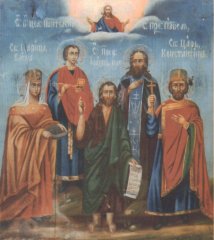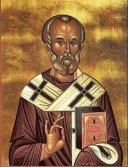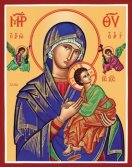
 |
 | 
|
Patron of the Byzantine Church | |
 |  |
 |
Through you, St. Basil, the enemies of Christ were confounded, the life of the spirit nourished, the purity of service held high. Pray for us that we may remain as steadfast as you, so that we may enter eternal life at the end. St. Basil was born in Caesarea in Asia Minor in 329 into an aristocratic family of great holiness - a number of saints were among his relatives and his family gave up some of its own to persecution. After his education, he was moved to follow |
| - from "Drinking from the Hidden Fountain" by Thomas Spidlik |
Return to Welcome, Return to Links, Return to Calendar, Return to top
 | You, O Holy One, have exercised your sacred ministry in Myra; and, in fulfillment of Christ's Gospel, you dedicated your life, O Venerable One, to your people and saved the innocent people from death. Thus, you have been sanctified as a great Servant of divine grace. |
|
St. Nicholas is especially revered in the East and is the patron of the Byzantine Catholic Church - a saint for whom many churches are named. He is also known as "St. Nicholas the Wonderworker" for the many miracles associated with him. He was born in a small town in what is now Turkey in the middle of the third century. Like both Ss. John Chrysostom and Basil, he was born into wealth but turned away from it to the greater riches of a life of service. It was the time of the ferocious persecutions under Diocletian and St. Nicholas suffered torture and imprisonment. But during the time of Constantine, the church had peace and St. Nicholas, freed, was raised to the office of Archbishop of Myra, the capital of Lycia. As a faithful shepherd, he was revered as a saint even before his death because of his great holiness and tender care of his flock, especially in his efforts to feed his people during times of famine. At the Council of Nicaea, he defended the truth of the true nature of Christ against the Arian heresy. He died in Myra on December 6th but the year is uncertain - that date is now his feast day. After the Blessed Mother and St. John the Forerunner, he was the most revered saint of the early church, being honored by Justinian by instituting a celebration of his feast day and erecting a magnificent church in his honor. His relics were transferred from the cathedral in Myra to Bari in Italy in the 11th century, thus he is sometimes known as St. Nicholas of Bari to differentiate him from others of the same name. His body exuded an ointment called myron, which was used for anointing the sick, leading to many miracles of healing. This phenomenon, called the "manna of St. Nicholas", was present even during an examination of his relics during a reinterment in the 1950's. The story most often recounted about the saint and which may be responsible for associating him with gift-giving relates the poverty of a father with three daughters. Too poor to provide dowries, the girls were in danger of being given into prostitution by their father, but St. Nicholas secretly threw a bag of gold coins in their window at three different times, enabling the girls to be married respectably. He is venerated as the patron saint of children, sailors and travelers. In Russia, he shares with St. Andrew the title of patron saint of that country. Today, his memory is often obscured in the West by the folklore grafted onto his name in the Christmas tales. |

|
The icon of Our Lady of Perpetual Help is perhaps the oldest actual icon of the Blessed Virgin. According to tradition, St. Luke wrote an icon of Our Lady while she was still living in Jerusalem. When she saw the beautiful icon of herself holding the Child Jesus in her arms, she blessed both the artist and his work proclaiming, "My grace will accompany this icon." The passage of centuries has proven that Mary did not forget this promise. So numerous were the miracles and favors granted by means of this Holy Icon, Pope Innocent III in 1207 stated that Mary's soul seemed to have entered into this icon since it was so beautiful and so miraculous. When St. Luke completed the icon, tradition tells us he gave it to his personal friend and patron, Theophilus. In the middle of the Fifth Century, St. Pulcheria erected a shrine in its honor in Constantinople. The icon remained there for a thousand years where it was venerated by countless Christians - kings and emperors, saints and sinners, rich and poor; and where it was the source of many graces. The original icon disappeared from human history during the siege of Constantinople in 1453. Tradition tells us that, on the night before the fall of the Holy City, the Holy Mother of God, took both the icon and the Imperial Crown to Heaven! Many copies that existed at that time have been preserved to this day. The spirit and miraculous power of the icon still live in the present day icon. The Holy Mother of God still lives among us, anticipating needs, saving, ministering, mothering - leading us to the Throne of Her Son in the Heavenly Kingdom. The Icon of Our Lady of Perpetual Help is an authentic expression of Byzantine art from ancient times. The gold background represents the Kingdom of God and the gold shining through the clothing reflects deification. The icon invites us to become sharers in this glory. The persons portrayed are: the Mother of God, Jesus Christ, the Archangel Michael, and the Archangel Gabriel. Mary's head is tilted with maternal affection toward the Christ Child on her left arm. Mary's eyes are not fixed on her Child or on the instruments of the Passion which the two angels hold out to Christ. Rather, she gazes toward those who are looking at the icon. With eyes and attitude of sorrow and love she invites all to consider Our Savior. The Christ Child has the appearance of apprehension when presented with the instruments of His Passion. In His mother, he finds the greatest comfort and tenderness. In his haste to run into her protective arms, He almost loses one of his tiny sandals thereby signifying to us that we should hasten to seek her loving assistance in our troubles. Christ's fingers hold his Mother's right hand, yet they rest quite loosely there. In this lies another lesson. Through the protection of His Most Holy Mother, Our Lord grew to His adulthood and initiated His Saving Work. As she protected Him, she prays for us still to Her Divine Son! |
 | Sermon of Saint Augustine, Bishop of Hippo
|
|
Saint Peter, the fervent follower of Jesus Christ, for the profound confession of His Divinity: "Thou art the Christ, the Son of the Living God", was deemed worthy by the Saviour to hear in answer: "Blessed art thou, Simon ... I tell thee, that thou art Peter [Petrus], and on this stone [petra] I build My Church" (Mt 16:16-18). On "this stone" [petra], is on that which thou sayest: "Thou art the Christ, the Son of the Living God" -- it is on this thy confession I build My Church. Wherefore the "thou art Peter": it is from the "stone" [petra] that Peter [Petrus] is, and not from Peter [Petrus] that the "stone" [petra] is -- just as how the christian is from Christ, and not Christ from the christian. Do you want to know, from what sort of "rock" [petra] the Apostle Peter [Petrus] was named? -- Hear ye the Apostle Paul: "I do not want ye not to know, brethren -- says the Apostle of Christ -- how our fathers were all under a cloud, and all passed through the sea: and all in Moses were baptised in the cloud and in the sea. And all thus eating spiritual food, and all thus drinking spiritual drink: for they did drink from the spiritual
accompanying rock: for the rock indeed was Christ" (1Cor 10: 1-4). Here is the from whence the "Rock" is Peter.
Our Lord Jesus Christ, in the final days of His earthly life, in the days of His mission to the race of man, chose from among the disciples His twelve Apostles for preaching the Word of God. Among them, the Apostle Peter for his fiery ardour was vouchsafed to occupy the first place (Mt 10:2) and to be as it were the representative person for all the Church. And therefore it is said to him, preferentially, after the confession: "And I give thee the keys of the Kingdom of Heaven: and if thou bindest upon the earth, it will be bound in the Heavens: and if thou loosenest upon the earth, it will be loosened in the Heavens (Mt 16; 19). Wherefore it was not one man, but rather the One Universal Church, that received these "keys" and the right "to bind and loosen." And that actually it was the Church that received this right, and not exclusively a single person, turn your attention to another place of the Scriptures, where the same Lord says to also all His Apostles: "Receive ye the Holy Spirit" -- and further after this: "Whoseso sins ye remit, are remitted them: and whoseso sins ye retain, are retained" (Jn 20:22-23); or: "with what ye bind upon the earth, will be bound in Heaven: and with what ye loosen upon the earth, will be loosened in the Heavens" (Mt 18:18). Thus, it is the Church that binds, the Church that loosens; the Church, built upon the foundational corner-stone -- Jesus Christ Himself (Eph 2:20) doth bind and loosen. Let both the binding and the loosening be feared: the loosening, in order not to fall under this again; the binding, in order not to remain forever in this condition. Wherefore "by the passions of his own sins -- says Wisdom -- is each ensnared" (Prov 5:22); and except for Holy Church nowhere is it possible to receive the loosening. And after His Resurrection the Lord entrusted the Apostle Peter to shepherd His spiritual flock not because, that among the disciples only Peter alone was pre-deserved to shepherd the flock of Christ, but Christ addresses Himself chiefly to Peter because, that Peter was first among the Apostles and as such the representative of the Church; besides which, having turned in this instance to Peter alone, as to the top Apostle, Christ by this confirms the unity of the Church. "Simon of John" -- says the Lord to Peter -- "lovest thou Me?" -- and the Apostle answered: "Yea, Lord, Thou knowest that I love Thee"; and a second time it was thus asked, and a second time he thus answered; being asked a third time, seeing that as it were not believed, he was saddened. But how is it possible for him not to believe That One, Who knew his heart? And wherefore then Peter answered: "Lord, Thou knowest all; Thou knowest that I love Thee." "And sayeth Jesus to him" all three times "Feed My sheep" (Jn 20:15-17). Besides this, the thrice appealing of the Saviour to Peter and the thrice confession of Peter before the Lord had a particular beneficial purpose for the Apostle. That one, to whom was given "the keys of the kingdom" and the right "to bind and to loosen," himself thrice bound himself by fear and cowardice (Mt 26:69-75), and the Lord thrice loosens him by His appeal and in turn by his confession of strong love. And to shepherd literally the flock of Christ was acquired by all the Apostles and their successors. "Attend yourself to all the flock" -- urges the Apostle Paul to church presbyters -- "in which the Holy Spirit hath established ye as bishops, to shepherd the Church of the Lord God, acquired by His Blood" (Acts 20:28); and the Apostle Peter to the elders: "Feed among you the flock of Christ, attending to it not by need, but by will and according to God: not for unrighteous profit, but zealously: not as commanding parables, but be an image to the flock. And when is appeared the Prince of pastors, ye will receive unfading crowns of glory" (1 Pet. 5:2-4). It is remarkable that Christ, having said to Peter: "Feed My sheep" -- did not say: "Feed thy sheep" -- but rather to feed, good servant, the sheep of the Lord. "For was Christ divided, or is Paul crucified according to you, or are ye baptised in the name of Peter or of Paul?" (1Cor 1:13). "Feed My sheep". Wherefore "wolfish robbers, wolfish oppressors, deceitful teachers and mercenaries, not being concerned about the flock" (Mt 7:15; Acts 20:29; 2Pet 2:1; Jn 10:12), having plundered a strange flock and making of the spoils as though it be of their own particular gain, they think that they feed their flock. Such are not good pastors, as pastors of the Lord. "The good pastor lays down his life for the sheep" (Jn 10:11), entrusted to Him by the Prince of pastors Himself (1 Pet 5:4). And the Apostle Peter, true to his calling, gave his soul for the very flock of Christ, having sealed his apostleship by a martyr's death, now glorified throughout all the world. And the Apostle Paul, being formerly Saul, was changed from a robbing wolf into a meek lamb; formerly he was an enemy of the Church, then is manifest as an Apostle; formerly he stalked it, then preached it. Having received from the high-priests the authority at large to throw all christians in chains for execution, he was already on the way, "he breathed with rage and murder against the disciples of the Lord" (Acts 9:1), he thirsted for blood, but -- "the Living One in the Heavens mocked him" (Ps 2:4). When he, "having persecuted and vexed" in such manner "the Church of God" (1Cor 15:9; Acts 8:5), he came nigh to Damascus, and the Lord from Heaven called to him: "Saul, Saul, wherefore persecutest thou Me?" -- and I am here, and I am there, I am everywhere: here is My head; there is My body. There becomes nothing of a surprise in this; we ourselves -- are members of the Body of Christ. "Saul, Saul, wherefore persecutest thou Me; it is terrible to thee to kick against the goad" (Acts 9:4-5). Saul, however, "trembling and frightened", cried out: "Who art Thou, Lord?" "I am Jesus" -- answered the Lord to him -- "Whom thou persecutest". And Saul suddenly undergoes a change: "What wantest Thou me to do?" -- he cries out. And suddenly for him there is the Voice: "Rise up and go to the city, and it will be told thee, what thou ought to do" (Acts 9:6). Here the Lord sends Ananias: "Rise up go upon the street" to a man, "by the name of Saul," and baptise him, "for this one is a vessel chosen by Me, to bear My Name before pagans and rulers and the sons of Israel" (Acts 9:11, 15, 18). This vessel mustneeds be filled with My Grace. "Ananias, however, answered: Lord, I have heard from many about this man, how much evil he hath done to Thine saints in Jerusalem: and to be here to have the authority from the high-priests to seize all calling upon Thy Name" (Acts 9:13-14). But the Lord urgently commands Ananias: "Search for and fetch him, for this vessel is chosen by Me: for I shalt tell him, how much mustneeds be for him to suffer about My Name" (Acts 9:11, 15-16). And actually the Lord did direct the Apostle Paul, what things he had to suffer for His Name. He instructed him the deeds; He did not stop at the chains, the fetters, the prisons and shipwrecks; He Himself felt for him in his sufferings, He Himself guided him towards this day. On a single day is done the memory of the sufferings of both these Apostles, though they suffered on separate days, but by the spirit and the closeness of their suffering they constitute one. Peter went first, Paul followed soon after him -- formerly called Saul, and then Paul, having transformed in himself his pride into humility, as means also his very name (Paulus), meaning "small, little, less," demonstrates this. What is the Apostle Paul after this? Ask him, and he himself gives answer to this: "I am" -- says he -- "the least of the Apostles: but more so than all I have laboured, yet not I, but the grace of God, which is with me" (1 Cor 15:9-10). And so, brethren, celebrating now the memory of the holy Apostles Peter and Paul, remembering their venerable sufferings, we esteem their true faith and holy life, we esteem the innocence of their sufferings and pure confession. Loving in them the sublime quality and imitating them by great exploits, "in which to be likened to them" (2 Thess 3: 5-9), and we shall attain to that eternal bliss which is prepared for all the saints. The path of our life before was more grievous, thornier, harder, but "how great the cloud of witnesses enveloping us" (Heb 12:1), having passed by along it, made now for us easier, and lighter, and more readily-passable. First there passed along it "the Founder and Fulfiller of faith" our Lord Jesus Christ Himself (Heb 12:2); His daring Apostles followed after Him; then the martyrs, children, women, virgins and a great multitude of witnesses. Who acted in them and helped them on this path? -- He that said: "Without Me ye are able to do nothing" (Jn 15:5). |